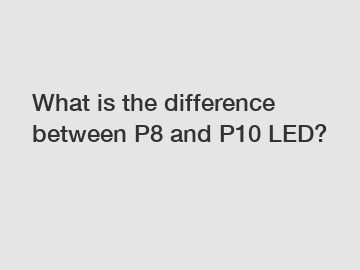What is the difference between P8 and P10 LED?
What is the difference between P8 and P10 LED?
LED displays have revolutionized the visual media industry, offering a wide range of possibilities for advertising, entertainment, and communication. Two popular types of LED displays are the P8 and P10, each with its own set of features and advantages. In this article, we will explore the key differences between P8 and P10 LED displays, allowing you to make an informed decision when choosing the right display for your needs.
1. Pixel Pitch:

The pixel pitch of an LED display refers to the distance between the center of two neighboring pixels. P8 and P10 are named after their respective pixel pitches, with P8 having a smaller pitch than P10. Generally, the smaller the pixel pitch, the higher the resolution and clarity of the display. P8 displays offer sharper images, especially when viewed up close, making them ideal for indoor applications where the audience is closer to the screen.
2. Viewing Distance:
The pixel pitch of an LED display directly affects the recommended viewing distance. P10 LED displays are better suited for larger viewing distances, such as stadiums or outdoor installations, where the audience is farther away from the screen. The larger pixel pitch allows for a better viewing experience without compromising image quality. On the other hand, P8 LED displays are better suited for indoor environments, trade shows, or smaller venues where the audience is closer to the screen.
3. Image Quality:
While both P8 and P10 LED displays offer impressive image quality, the difference lies in the level of detail and sharpness. P8 displays have a higher pixel density compared to P10, resulting in a more detailed and vibrant image. This makes P8 displays particularly suitable for applications that require close-ups or detailed visuals, such as product launches, art galleries, or museums. P10 displays, although slightly less detailed, still deliver exceptional visual performance and are well-suited for most outdoor applications.
4. Brightness and Power Consumption:
To ensure optimal visibility, LED displays need to have a suitable brightness level. P10 displays generally have a higher brightness level than P8 displays, making them more suitable for outdoor applications where ambient light conditions may be challenging. However, this higher brightness level also leads to increased power consumption. P8 displays, with their smaller pixel pitch, can achieve higher brightness levels while consuming relatively less power, making them a greener and more cost-effective choice for indoor applications.
In conclusion, the difference between P8 and P10 LED displays lies primarily in their pixel pitch, viewing distance, image quality, and brightness levels. While P8 displays offer higher resolution and sharper images, making them well-suited for indoor applications, P10 displays excel in outdoor environments with larger viewing distances. Understanding these differences can help you make an informed decision when choosing the right LED display for your specific needs, ensuring maximum visual impact and viewer satisfaction. So, whether you require a vibrant indoor display or a reliable outdoor signage solution, consider the differences between P8 and P10 LED displays and select the one that aligns with your requirements.
Want more information on variable message signs price, variable message sign boards, "Speed Limit Sign (SLS)? Feel free to contact us.


Comments